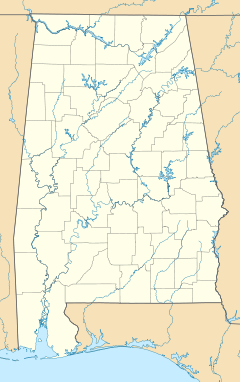- National African American Archives and Museum
-
Davis Avenue Branch, Mobile Public LibraryThe National African American Archives and Museum in 2008.
Location: 564 Martin Luther King Jr. Drive
Mobile, Alabama, United StatesCoordinates: 30°41′43.12″N 88°3′3.71″W / 30.6953111°N 88.0510306°WCoordinates: 30°41′43.12″N 88°3′3.71″W / 30.6953111°N 88.0510306°W Built: 1931 Architect: George Bigelow Rogers Architectural style: Classical Revival[1] Governing body: Private NRHP Reference#: 83003459[1] Added to NRHP: 22 December 1983[1][2] The National African American Archives and Museum, formerly the Davis Avenue Branch of the Mobile Public Library, is an archive and history museum located in Mobile, Alabama. It serves as a repository for documents, records, photographs, books, African carvings, furniture, and special collections that all relate to the African American experience in the United States.[3]
History
The Davis Avenue Branch of the Mobile Public Library was built in 1931 to serve the needs of the local African American community.[4] The building was modeled after the Ben May Main Library but constructed on a smaller scale. The local African American community helped collect used books for the library and raise funds for the acquisition of new books. This reflected the social reality of segregation, when African Americans were prevented from participating fully in educational endeavors and were provided with separate educational facilities. Following desegregation, this branch library became a repository for government documents.[2] It was later reopened as the National African American Archives and Museum. The museum building is listed on the National Register of Historic Places and was designed by noted architect George Bigelow Rogers.[5]
Exhibits
Exhibits include the "History of Colored Carnival" that details the African American contribution to Carnival and Mardi Gras.[3] Also, the "Slavery Artifacts" exhibit features authentic displays of shackles, leg irons, slave collars, slave bracelets and slave badges from before the time of the Emancipation Proclamation.[3] On a more localized note, the museum also features artifacts representing the numerous contributions African Americans have made to greater Mobile.[5] It chronicles the voyage of the last known illegal slave ship, the Clotilde, which docked in Mobile in 1860 and led to the establishment of Africatown.[5] Mobile's African American community has produced such famous personalities as baseball legend Hank Aaron and U.S. Labor Secretary Alexis Herman, who both are represented in the museum's collection.[5]
References
- ^ a b c ""Alabama: Mobile County "". "National Register Historic Places". http://www.nationalhistoricalregister.com/al/mobile/state.html. Retrieved 2007-01-03.
- ^ a b "National Register Information System". National Register of Historic Places. National Park Service. no date specified. http://nrhp.focus.nps.gov/natreg/docs/All_Data.html.
- ^ a b c ""Itineraries: National African-American Archives Museum"". "Mobile Bay Convention and Visitors Bureau". http://www.mobile.org/gr_itin_aahrtg.php. Retrieved 2007-12-11.
- ^ Thomason, Michael. Mobile : the new history of Alabama's first city,pages 201-202. Tuscaloosa : University of Alabama Press, 2001. ISBN 0817310657
- ^ a b c d ""National African-American Archives Museum"". "Soul of America". http://www.soulofamerica.com/index.php?id=6673,1740,0,0,1,0. Retrieved 2007-12-11.
U.S. National Register of Historic Places Topics Lists by states Alabama • Alaska • Arizona • Arkansas • California • Colorado • Connecticut • Delaware • Florida • Georgia • Hawaii • Idaho • Illinois • Indiana • Iowa • Kansas • Kentucky • Louisiana • Maine • Maryland • Massachusetts • Michigan • Minnesota • Mississippi • Missouri • Montana • Nebraska • Nevada • New Hampshire • New Jersey • New Mexico • New York • North Carolina • North Dakota • Ohio • Oklahoma • Oregon • Pennsylvania • Rhode Island • South Carolina • South Dakota • Tennessee • Texas • Utah • Vermont • Virginia • Washington • West Virginia • Wisconsin • WyomingLists by territories Lists by associated states Other  Category:National Register of Historic Places •
Category:National Register of Historic Places •  Portal:National Register of Historic Places
Portal:National Register of Historic PlacesMobile, Alabama Culture Azalea Trail Maids · Bayfest · Mardi Gras · Mobile Carnival Museum · Mobile Museum of Art · Mobile Opera · Mobile Symphony Orchestra · Mystic society · People from Mobile · Saenger Theatre
History and tourism National Register of Historic Places listings · Africatown · Barton Academy · Battleship Memorial Park · Bellingrath Gardens and Home · Bragg-Mitchell Mansion · Cathedral Basilica of the Immaculate Conception · Catholic Cemetery · Church Street Graveyard · Clotilde · Conde-Charlotte House · Convent and Academy of the Visitation · Fort Conde · Government Street Presbyterian Church · Gulf, Mobile, and Ohio Passenger Terminal · History of Mobile · Magnolia Cemetery · Mobile Bay · Mobile Botanical Gardens · Mobile-Tensaw River Delta · Most Pure Heart of Mary Catholic Church · Museum of Mobile · National African American Archives and Museum · Oakleigh · Richards DAR House · USS Alabama (BB-60) · USS Drum (SS-228)Parks Categories:- Museums in Mobile, Alabama
- National Register of Historic Places in Mobile, Alabama
- Archives in the United States
- George Bigelow Rogers buildings
- African American museums in Alabama
- African American Heritage Trail of Mobile
- Classical Revival architecture in Alabama
- American national museums in Alabama
Wikimedia Foundation. 2010.


